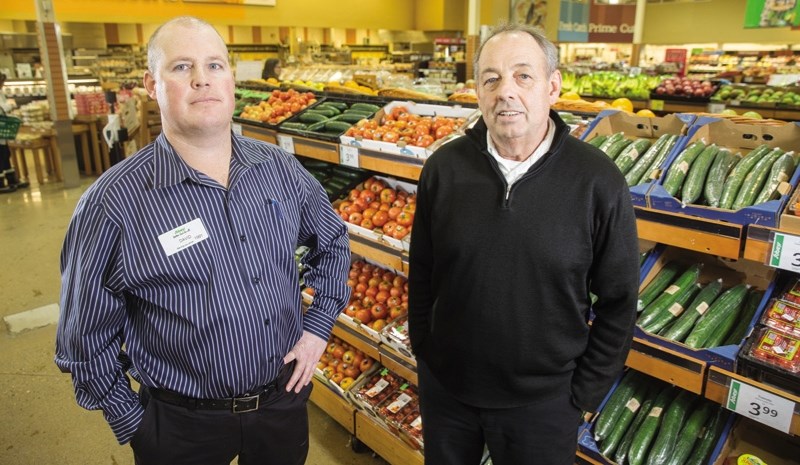Expect to pay more for fresh produce and groceries or for trips south of the border as the Canadian dollar dips to levels not seen for more than a decade.
The loonie slipped below 69 cents U.S. last week for the first time since 2003 and some forecasts call for the loonie dropping as low as 59 cents U.S. With a value of 70 cents U.S., that means it will cost Canadians nearly $1.44 to get one American dollar.
According to David Gilbert, owner of Okotoks Sobeys, the low Canadian dollar could result in higher prices for food and produce.
“Anything that originates out of the U.S., either manufactured or grown, we’re at risk with the way the Canadian dollar is,” said Gilbert.
He has seen costs escalate because of the low Canadian dollar. The situation has been compounded by poor weather in major growing areas like California.
There are winners and losers as the dollar drops.
Gilbert said prices haven’t risen to the point where he has had to stop stocking some items, but he had to cut back on the amount of some items kept on stock at Sobeys, or they are putting less out for display.
“We’ve adjusted out merchandising and our display size of that item that may be twice as expensive as it was this time last year, or twice as expensive as it was in November, it’s out in smaller quantities,” said Gilbert.
Whether prices moderate in the coming months will depend on the price of the dollar and weather in major growing regions, he says.
“It’s that old supply and demand,” Gilbert said. “There’s not a lot of supply out there and what there is is expensive.”
Dave Heron, owner of Pacesetter Travel, said he hasn’t seen the full impact of the lower value for the loonie, but said it’s coming.
“Oh that hurts, that’s a painful conversation,” he said.
Heron said most travelers purchased packages and trips months in advance when the Canadian dollar was still worth more.
“A lot of trips were booked back in July when the dollar wasn’t as terrifying as it is now,” he said.
Heron said it will take a few months to see how Canadian’s adjust their travel habits, but he is seeing some changes.
He said snowbirds heading south to U.S. sun states are still going ahead with travel plans, but they’re not planning to stay for nearly as long. Rather than heading to Hawaii or Florida, he added people are looking at other lower-cost destinations.
Heron said he is also seeing more interest in travel to the Maritimes, particularly in spring and fall, and in eastern seaboard cruises leaving Canada and spending limited time in the U.S.
“Folks for the first time in seven or eight years are looking at alternatives, perhaps more than they would have,” he said. “Whether that translates into a definite change in their travel patterns, we probably won’t know that for three to five months.”
Heron said the low price of oil is one silver lining for the travel industry as it has helped to keep airfares down and temper the impact of the low loonie.
According to a Blackie-area farmer, agricultural producers will see two sides of the coin from the low price of the loonie.
Leroy Newman said anyone exporting their grain or livestock products are able to take advantage of the low Canadian dollar.
However, they will feel the pinch when it comes time to buy new machinery, fertilizer or other essentials, which are often priced in U.S. dollars.
“If we try to go and buy a combine now, it’s 40 per cent higher,” he said.
“If we try to buy fertilizer, our fertilizer is really cheap so the U.S. comes up and buys out fertilizer so we have to pay U.S. rates. Our chemicals will follow, our groceries are going higher.”
Newman said a lower-value Canadian dollar may help in the short term.
“With our cattle for sure and with our grains it’s somewhat better,” he said.
Newman said he won’t buy a new combine this year, he’ll buy a used one so he can pay in Canadian dollars.
However, even the price of used equipment is also going up because Americans are shopping for lower cost Canadian equipment, he said.
According to Newman, it’s helped that prices for some agricultural commodities have remained positive and where they are down, the low Canadian dollar has given producers a buffer.
He said a large corn and soybean crop in the U.S. has driven prices down, but the low Canadian dollar has helped insulate Canadian producers.
“They’ve lost 25 per cent or 30 per cent, there are a lot of complaints down there about break even crops while we’re all looking at 20 per cent profits,” he said.
Ultimately, he said farmers will feel it when the Canadian dollar rises back up again.




